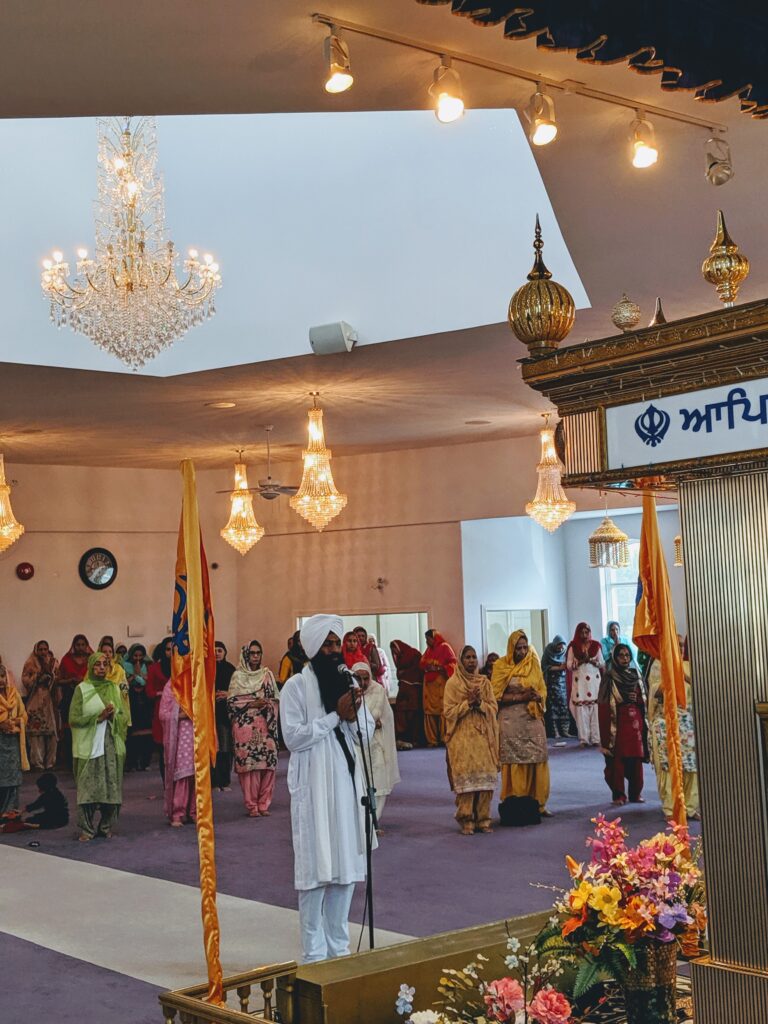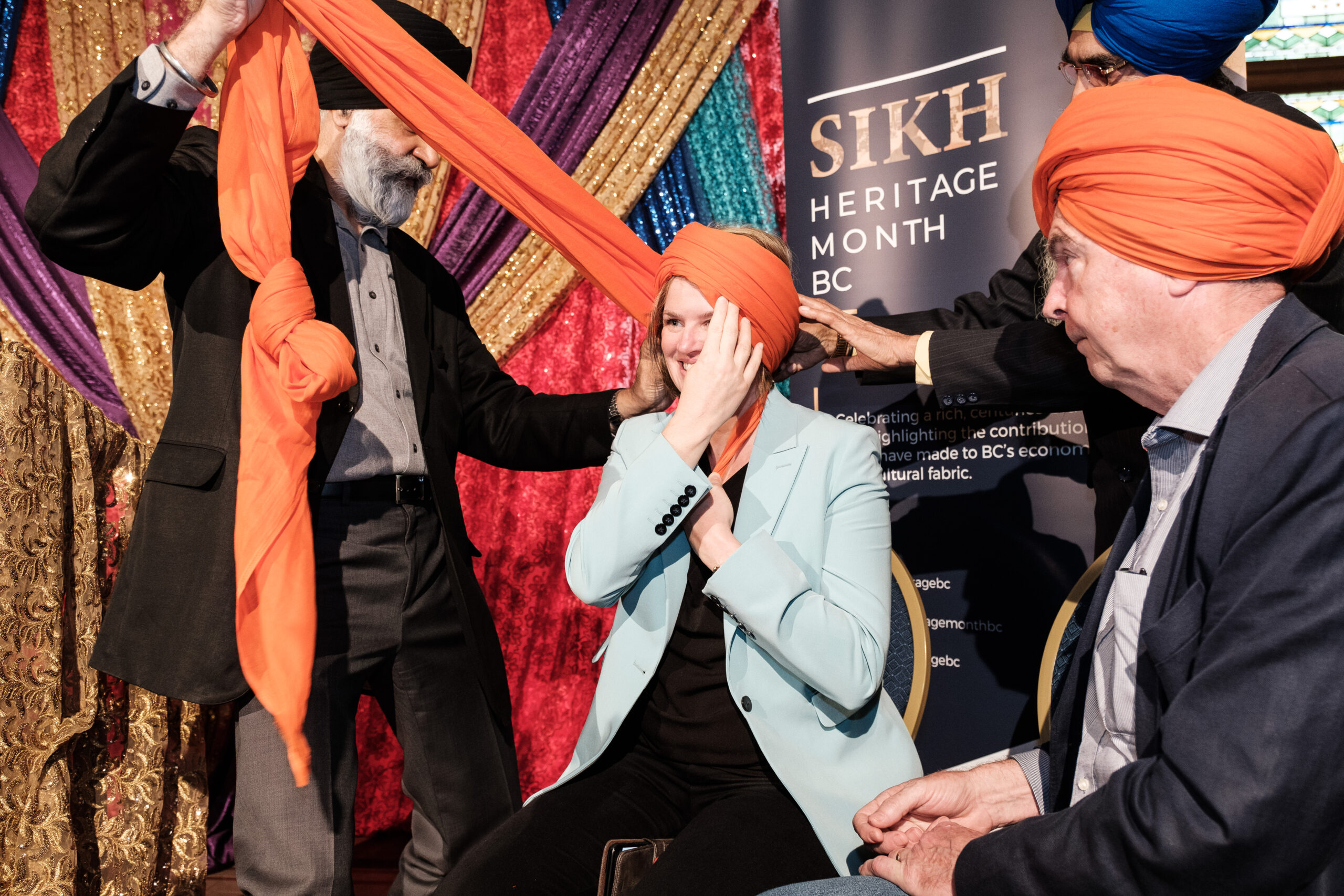The Community
The Kamloops Sikh community is vibrant and provides selfless service to Kamloops, making it a noticeable minority group of Kamloops. According to the 2021 census, the Sikh population of Kamloops is 2,005 persons, which makes up 2.1% of the population. There are two Gurudwara (Sikh Temple), and both have services on Sunday. This number will only grow daily, with international students coming. The citizens of Kamloops can feel the presence of the Sikh community. When the highways closed, both Gurudwaras gave free food to truckers. Also, every April, the Sikh community does a Sikh parade, the nagar kirtan. In 2016, a Sikh farmer in Kamloops saved a drowning girl’s life by using his turban.

Kang, G. (2019). Kamloops Gurudwara Sahib Society Sangat (fellowship) [Photograph].
The Opportunity
The workshop fosters diversity and understanding within Kamloops by directly exposing participants to Sikhism and the cultural significance of the turban. This breaks down barriers and promotes a more inclusive environment. The workshop isn’t just about information; it offers hands-on learning. This active participation makes it more engaging and impactful for those wanting a deeper cultural understanding. Sadly, turbans can sometimes be linked to misunderstandings or stereotypes. This respectful workshop perfectly addresses these preconceptions and promotes acceptance through direct experience and education. Cultural tourism is on the rise. This workshop is a unique, authentic experience that aligns with this trend and makes Kamloops a more attractive destination.
Holding the workshop during Sikh Heritage Month amplifies its reach and relevance, creating a powerful platform for cultural awareness. By involving local members of the Sikh community, the workshop becomes a vehicle for shared stories and builds stronger connections within Kamloops. It showcases community engagement and fosters a sense of belonging. This isn’t a lecture; it’s about doing and trying. This participatory element sets it apart from typical tourism activities and makes it more memorable. The structure emphasizes a thoughtful, respectful approach to learning about Sikh culture, making it a welcoming space for everyone, regardless of their background. This type of deep, personal learning experience about Sikh culture likely doesn’t exist elsewhere in Kamloops’ tourism offerings, making it valuable and sought-after.

“Singh at Studio while shooting Patiala shahi turban style Video Tutorial during the time of Covid-19 Pandemic Lockdown” by SHAHI PAGG TURBAN is licensed under the Creative Commons Attribution-Share Alike 4.0 International license
The Experience
The experience will include a presentation on the basics of the Sikh faith, its history, core values, and how to show respect within a Gurudwara (Sikh place of worship), as well as videos/presentations on what the turban symbolizes, its historical importance, and stories about its role in the Sikh identity.
The activity will be in partnership with the Kamloops Gurudwara Sahib Society and will be the workshop’s location. The location within the gurudwara will be either the langar hall (dining hall) or the gallery hall.
This will be “small” since the number of volunteers needed from the local Sikh community is around 5.
Financially, this will be a non-profit model supported by donations, volunteers, and the gurudwara.
After talking to the Gurudwara committee, the best day to hold the workshop is April 13 since that is the day the Kamloops Gurudwara Sahib Society celebrates Vaisakhi (Celebration of Khalsa). The workshop will be held from 8 am to 10 am. Afterwards, the Gurudwara will start its celebration from approximately 10:30 am till 1 pm, and participants of the workshop will be welcome to stay as long as they please.
The groups will consist of 10-15 participants per workshop. The potential users of this activity are residents of the Kamloops community, including Sikh youth who are transitioning into turban-tying, individuals of any gender, race, colour, or religion interested in learning about Sikhism and the turban, and tourists and community members seeking unique cultural experiences.
The workshop will have four components:
The first is an Introduction to Sikhism. This will include a brief overview of Sikh history, core values, and respect for the Sikh place of worship (Gurudwara).
The second component is The Turban: Significance and History. This will include presentations and videos highlighting the turban’s symbolism, historical uses, and stories demonstrating its importance.
The third component includes Turban Styles. This will showcase the different turban styles to the participants, focusing on popular choices like the Vattan Wali, Patiala Shai, and Morni.
The fourth component is Hands-On Turban Tying. This will include step-by-step instruction led by skilled instructors, with various colours and fabrics for participants to experience.
For maximum relevance, the workshop will be held during Sikh Heritage Month (April).
Preparatory work will be needed, such as getting volunteers, making donations to supply the workshop with turbans, and promoting it at places such as TRU with posters and online with social media and ads. The aim of this activity is to increase awareness of Sikhism and the significance of turbans within Kamloops and create positive interactions between tourists, community members, and the local Sikh population.
Turban Styles:
Patiala Shai Turban originated from Maharaja Bhupinder Singh of Patiala. The turban style translates to the Royal Turban of Patiala. What makes the Patiala Shai Turban unique is that it is layered visibly on both sides of the turban. This is unique compared to Morni style, which only has visible layers on one side. The Patiala Shai Turban offers a taller look, and many tie this style for formal occasions and weddings. Many famous Punjabi actors, like Diljit Dosanjh, Ammy Virk, and Ranjit Bawa, are just a few examples tie this style. This style can be seen in the third picture of this article. Shai Pagg Turban is famous for his YouTube tutorials with multiple videos on how to tie different styles of turban.
Morni Turban is a classic style of turban and from my knowledge it initially was a simple style that developed into a neatly folded, triangular shape turban. It gives the turban a beak like appearance. This turban is known for its clean layers and pointy shape. It’s a stylish style that can be worn for any type of events. Inderjit Nikku was one of the singers that made this style famous.
Vattan Wali Turban is a type of turban where the layers are not clean. This creates a textured and slightly more casual look compared to some smoother styles. This contributes to a more relaxed and everyday vibe.The vattan wali pagg is a common and practical turban style, often seen in everyday life. It’s less formal than some other elaborate styles. Majority of Punjabi artists tie this style. Examples include Sidhu Moose Wala, Diljit Dosanjh, Ammy Virk, and Tarsem Jassar.
Caption for picture below:
“Jassi Sidhu, Belfast Mela, Botanic Gardens, Belfast, Northern Ireland, August 2010” by Ardfern is licensed under the Creative Commons Attribution-Share Alike 3.0 Unported license
“Diljit Dosanjh grace the media meet of Philla” by Bollywood Hungama is licensed under the Creative Commons Attribution 3.0 Unported license
“Sidhu Moosewala during the shooting of his film Moosa Jatt” by Shekha Gill is licensed under he Creative Commons Attribution-Share Alike 4.0 International license
“Ammy, virk snapped on sets of the kapil sharma show promoting film “Buj Pride India”” by Bollywood Hungama is licensed under the Creative Commons Attribution 3.0 Unported license

The Benefit
The workshop breaks down cultural barriers by educating participants about Sikhism, its values, and the significance of the turban. This direct knowledge fosters understanding and combats stereotypes. The hands-on aspect allows people to step directly into the experience of wearing a turban. This personal interaction helps dispel misconceptions and builds empathy. Kamloops lacks this specific type of immersive cultural experience. The workshop becomes a drawcard for tourists who value authenticity and local experiences. This benefits Sikh small businesses and raises Kamloops’ profile as a culturally diverse destination.
The Sikhs of Kamloops get to share their heritage proudly, creating a sense of belonging and fostering mutual respect within the broader community. The very nature of the workshop encourages friendly interactions among the local Sikh population, community members, and tourists. This strengthens community ties. The workshop’s reliance on local volunteers and its location within the Gurudwara underscore its role in empowering the Sikh community and making it a collaborative community project.
